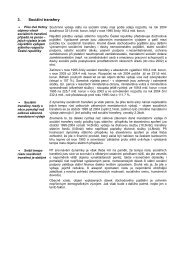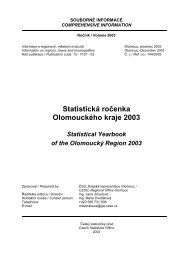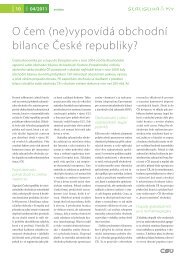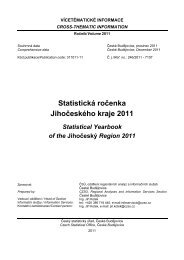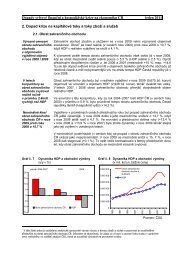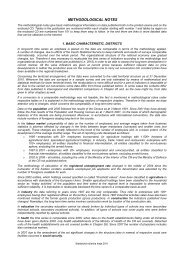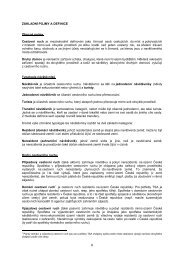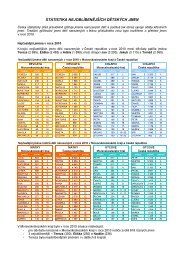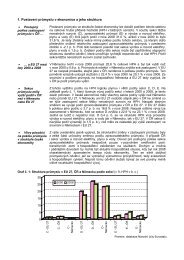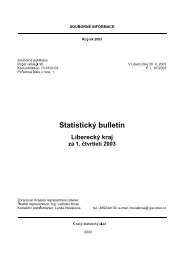Statistická ročenka Olomouckého kraje 2011 - Český statistický úřad
Statistická ročenka Olomouckého kraje 2011 - Český statistický úřad
Statistická ročenka Olomouckého kraje 2011 - Český statistický úřad
Create successful ePaper yourself
Turn your PDF publications into a flip-book with our unique Google optimized e-Paper software.
5. MACROECONOMIC INDICATORS<br />
Regional accounts, the only source of regional macroeconomic indicators, are a regional analogy to national accounts.<br />
They result from annual national accounts compiled for the Czech Republic; as for the methodology they correspond to<br />
the European System of Accounts (ESA95) and consistently observe rules and recommendations valid for Member<br />
States of the European Union, which means that they are comparable to them - harmonized.<br />
The Czech Statistical Office has made an extraordinary revision of the national accounts for the years 1995–2009<br />
together with a preliminary version for 2010. The main reason for that was a transition to the new CZ-NACE<br />
classification. More detailed information on the results of the extraordinary revision of the national accounts can be found<br />
at the CZSO webpage: http://apl.czso.cz/pll/rocenka/rocenka.indexnu_en. In harmony with the ESA95 methodology<br />
indicators are surveyed by a workplace method, which means that indicators for enterprises are allocated to regions<br />
according to the real place of work of a unit. Gross value added for multi-regional organizations is allocated based on<br />
wages paid in individual regions. Indicators of household accounts are related to the place of residence of the<br />
households.<br />
Gross domestic product (GDP) is a key indicator of the development of the economy. It is a set of values added of<br />
individual institutional sectors or individual industries in activities considered by the ESA95 to be productive (i.e. including<br />
both market and non-market services) and net taxes on products (it is thus expressed in purchaser prices). From the<br />
point of view of use, GDP is equal to the sum of final consumption (of households, government and non-profit institutions<br />
serving households), gross capital formation (fixed capital and balance of inventories and acquisitions less disposals of<br />
valuables) and the external trade balance.<br />
Gross value added (GVA) is the sum of values added of individual industries (i.e. GDP excluding net taxes on products,<br />
which cannot be divided among individual industries). The industrial structure is arranged according to the CZ-NACE<br />
classification, which corresponds as for its content to the European NACE Rev. 2 classification.<br />
Gross fixed capital formation (GFCF) includes the value of acquisition of both tangible and intangible fixed assets<br />
purchased, taken over free of charge or produced by own activities, deduced by the value of its sale and free transfers.<br />
What is also included is acquisition in the form of financial leasing. The target of the acquisition is always to use the fixed<br />
assets for productive activity including housing in the dwelling of its owner. What is not included are fixed assets worth<br />
less than CZK 20 thousand, consumer durables purchased by households for satisfaction of final consumption or<br />
acquisitions less disposals of valuables. Excluded is also equipment for military purposes (tanks and suchlike) and<br />
expenditure on research and development and the like.<br />
Net disposable income of households is an amount that households can give to final consumption, savings in the form<br />
of financial assets and to accumulation of both tangible and intangible assets. Disposable income results from the<br />
creation and distribution of income and it is the balancing item of the secondary distribution of income account.<br />
For the needs of the international comparison the selected indicators are converted to currency unit Euro, purchasing<br />
power standard and purchasing power consumption standards, namely according to the coefficients issued by the<br />
Statistical Office of the European Union - Eurostat.<br />
Regional macroeconomic indicators are revised in harmony with the revisions of annual national accounts. Data on the<br />
year 2008 are based on the final version of annual national accounts for the year 2008, data on 2009 are based on the<br />
half-finalised version and data on 2010 are based on a preliminary version of annual national accounts.<br />
External trade is after the accession of the Czech Republic to the European Union the sum of the intra-EU trade (i.e.<br />
trade with the EU Member States) and the trade with countries out of the EU. In the regional breakdown, only data on<br />
exports of goods of individual regions are published, because at imports, the precise place (region) of final use of goods<br />
is unknown in many cases. At determination of the region of the origin of exports the reporting units can choose also<br />
“unspecified” as one of the possibilities and thus the sum of individual regions is not equal to the value of exports for the<br />
entire Czech Republic. Data from export statistics are published in FOB values (it means own value of goods and direct<br />
trading costs associated with transport to the state border of the CR) and they are shown in current prices. The value in<br />
EUR is the sum of values in CZK converted by the average CZK exchange rate reported by the Czech National Bank.<br />
Goods are classified according to the Standard International Trade Classification - SITC Rev. 4.<br />
6. LOCAL GOVERNMENT BUDGETS<br />
The chapter contains selected data on revenue and expenditure of regions, municipalities and voluntary unions of<br />
municipalities. Data are taken over from the Ministry of Finance of the CR, which processes the necessary data from<br />
accounting and financial statements of individual territorial units.<br />
Revenue and expenditure are after consolidation, i.e. after elimination of duplicities and entries, which are not a direct<br />
part of the financial performance.<br />
7. PRICES<br />
Consumer prices of selected price representatives are average consumer prices surveyed in the region in December of<br />
a reference year. Their arrangement in the table is based on the consumer basket structure (i.e. a set of selected kinds<br />
of goods and services paid for by the population including weights assigned to them) which has been valid since 2007.<br />
194<br />
<strong>Statistická</strong> <strong>ročenka</strong> <strong>Olomouckého</strong> <strong>kraje</strong> <strong>2011</strong>



